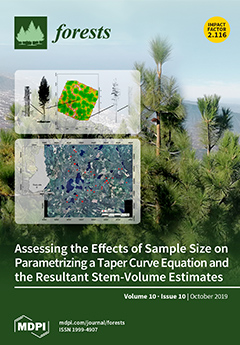Phytophthora species are well-known destructive forest pathogens, especially in natural ecosystems. The wild apple (
Malus sieversii (Ledeb.) Roem.) is the primary ancestor of
M. domestica (Borkh.) and important germplasm resource for apple breeding and improvement. During the period from 2016 to 2018,
[...] Read more.
Phytophthora species are well-known destructive forest pathogens, especially in natural ecosystems. The wild apple (
Malus sieversii (Ledeb.) Roem.) is the primary ancestor of
M. domestica (Borkh.) and important germplasm resource for apple breeding and improvement. During the period from 2016 to 2018, a survey of
Phytophthora diversity was performed at four wild apple forest plots (Xin Yuan (XY), Ba Lian (BL), Ku Erdening (KE), and Jin Qikesai (JQ)) on the northern slopes of Tianshan Mountain in Xinjiang, China.
Phytophthora species were isolated from baiting leaves from stream, canopy drip, and soil samples and were identified based on morphological observations and the rDNA internal transcribed spacer (ITS) sequence analysis. This is the first comprehensive study from Xinjiang to examine the
Phytophthora communities in wild apple forests The 621 resulting
Phytophthora isolates were found to reside in 10 different
Phytophthora species: eight known species (
P. lacustris being the most frequent, followed by
P. gonapodyides,
P. plurivora,
P. gregata,
P. chlamydospora,
P. inundata,
P. virginiana, and
P. cactorum) and two previously unrecognized species (
P. sp. CYP74 and
P. sp. forestsoil-like). The highest species richness of
Phytophthora occurred at BL, followed by XY.
P. lacustris was the dominant species at BL, XY, and JQ, while
P. gonapodyides was the most common at KE. In the present paper, the possible reasons for their distribution, associated implications, and associated diseases are discussed.
Full article





